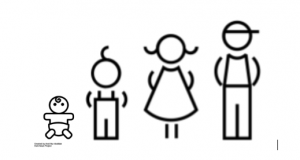17
Oriahna Nueske
Motivation can be complicated, convoluted, multifaceted or sometimes even straightforward and easy to understand. The surface definition of motivation being, the initiative behind any and all behaviors. We as a species are motivated into action to have both our physiological and our psychological needs met. It may seem strange, but depending on context, people actually prioritize their psychological needs over their physiological needs(Kleinknecht, 2020). That concept in and of itself is a little problematic, this framing of the two needs competing with each other. I would like to quickly quash any further concepts of psychological needs vs physiological needs. It can be difficult to tell preference from need at times, especially for children, but all people experience psychological needs that must be addressed at risk of death. Infants who do not experience an emotionally warm, supportive environment are at risk of a fatal condition called Failure to Thrive (Kleinknecht, 2020).

The way people experience motivation changes throughout life, based on both lived experiences and brain development (Eccles & Wigfield, 2002, Crone & Fuligni, 2020). People are motivated by what knowledge they have, and how they can relate to it in order to form the mental frameworks of self schemas, self-concepts, selfways, and identity (Kleinknecht, 2020). Self-concept is information we relate to, self schemas are how we relate to groups and communities of members therin. Selfways are culture-bound parts of our self-concept and identity which make up some of our most foundational concepts of self. Identity is a sum total of self including culture, beliefs, and values, everything a person has dedicated themself to.
There are five types of self-knowledge people can experience (Kleinknecht, 2020). At infancy, self is highly reflexive and limited to present-tense ecological and interpersonal knowledge. Infants are aware that they currently occupy a physical space, and that other people currently exist too. Children around the age of 5 form a very basic self-concept and self-schemas as they develop the capacity for extended, and private knowledge. This means young children understand that they are an extension of their younger selves, and are capable of remembering past experiences. Young children are also aware that anyone can experience thoughts, and these thoughts are private until shared. Self-concept and self-schemas start out as very literal concepts, made almost entirely of descriptions of personal appearances. In grade school self-concept and self-schemas change to include more complex ideas. Finally in adolescence, people develop their identity (Crone & Fuligni, 2020). The frontal cortex increases in size and myelination in adolescence, allowing for adolescents to move beyond current, and past experiences, into future potentials.

The neurotypical brain goes through a progression of blooming, pruning, myelination and neural integration as we age. Throughout infancy and into early childhood the brain is focused mainly on blooming, or growing and taking in new information through a huge neurological network. This network is important for survival but requires a huge amount of energy to operate, so between the ages of 5-9 the brain undergoes a pruning phase (Kleinknecht, 2020). Unused information-storing synapses are removed to conserve energy and improve neural efficiency. The brain begins myelinating connections starting at adolescence and around age 20 we experience neural integration.
Some parts of motivation, self, and identity progress along an expected developmental path with age based landmarks (Crone & Fuligni, 2020). Cognitive perspectives in how we can relate to the world follow a similar path throughout childhood, but after adolescence our perspectives become experience-based rather than growth-based (Kleinknecht, 2020). Infant perspectives are egocentric, they do not have the capacity to consider the wants and needs of other people, and can only think about their wants and needs. Young children have social-informational perspectives which allow them to realize that other people might have different ways of thinking, but they can’t understand what those might be. Children have self-reflective perspectives between 5-9 where they gain the understanding that other people have different thoughts because they have different life experiences. Third party perspectives are where a person can understand a situation from three different perspectives. Third party perspectives are experience based, and can start in adolescence, but can also be difficult for some fully myelinated adults to understand. Lastly societal perspectives are difficult for most adults to understand and not really possible for non-adults to understand. Societal perspectives involved understanding the massive amounts of other people in a society, and how their identities and motivations can lead to complicated disagreements in societal relations.
Neurological growth, experiences, and perspectives all tie into self-concept and identity development. Now that a baseline has been established age-based psychological-social capabilities, self-regulation and motivation can be understood. Once people have established a self-concept, they actually tend to have quite a few self-concepts (Eccles & Wigfield, 2002, Master, 2016 ). We have an idealized version of ourselves which serves as a goal we are motivated to reach by behaving in ways that would best suit that ideal. We also have our working-selves which vary on the goals we set within different contexts. The goals a child sets in one academic context might be different from another academic context, the same can be said with home, family, play, and any kind of context (Master, 2016).
Motivation is a powerful force that can be influenced with incredible ease by the terminology surrounding people. When working with children it is important to cultivate their motivation by avoiding static-labels. When a child is praised for their effort, they experience a growth mindset (Master, 2016). They see the effort as being important, they associate that effort as a part of themself. Praised efforts become a part of their self-concept that children can put energy towards so that concept can be nurtured and used as a goal in future contexts (Kleinknecht, 2020). Static-labels enable a fixed mindset, wherein the labels become mental-trophies that require no energy to maintain. No further goals need to be set, because a goal has already been achieved. People prefer to identify with static labels, even in adulthood. People want to hold positive static-labels like voters, and avoid negative static labels like cheaters (Master, 2016). Static may be comfortable, but it is the exact opposite of the growth and change we want to encourage in growing milds.
It is best to try to avoid labels, but labels are currently unavoidable in some contexts. Stereotypes are a prevalent part of our society, and developmentally-capable children will pick up on terms and behaviors associated with the groups they are, and are not a part of (Master, 2016). It is important to consider and address how both positive and negative stereotypes exist as stress-inducing lifelong threats to motivation, performance, self-concept and identity. Stereotypes can affect how an adult professional sees a child in their care, how other children see a child, and how a child sees themselves. Some of these stereotypes can be addressed effectively via high standards and assurance feedback (Master, 2016). Explain age-appropriate behaviors and goals to the children in your care, and give them affirmation that you believe they are capable of meeting your standards. Give students encouraging, growth-based feedback and keep language free of racial associations. We as professionals are not immune to the comfort of static labels, and must always put effort into maintaining an environment of unconditional support for the children in our care.
Occupational therapists in elementary schools working to help students manage developmental or diminished motor skills, have to be mindful of both physiological and psychological limits and capabilities in the children they work with. The use of the word “both” was a trick; did you catch it? Remember the green paint from earlier. Occupational therapists cannot separate physiological and psychological concepts when caring for someone. This concept is gaining popularity across different fields, but it’s always been the backbone of occupational therapy ideology. The concept which helps define occupational therapy as not-quite psychology, and not-quite physical therapy. When working with a child we must make care plans based on the entire child, not just a diagnosis-label and frustrated stories from other caregivers.
We need to know where the child is at with muscle development, neural and cognitive capabilities to make an effective treatment plan, but we also need to find ways of motivating them through that treatment plan. This can be difficult when a child finds their treatments boring, irritating, or painful. Occupational therapists can use and reframe the expectancy-value model of achievement when helping to motivate children through the therapeutic process. Children may not agree that their perceived motivational cost of time, energy, and pain is worth the utility value of their therapeutic outcome (Eccles & Wigfield, 2002). Some specific care plans can be painful and uncomfortable at times, but we need to aim to reduce discomfort and frustration by setting realistic and holistic therapy goals for the child. It can be difficult at any age to be motivated deeply to achieve a goal someone else has set for you, why would anyone expend their limited energy on a goal that lacks any associated desire? Carefully frame their utility value as a part of something they want. Explain that the challenge of therapy comes with a behavioral prize that they can set for themselves.Therapeutic goals need to account for a child’s lived experiences and include short and long-term goals children choose in order for the child to be motivated.
References
Crone, E. A., & Fuligni, A. J. (2020). Self and Others in Adolescence. Annual Review of Psychology, 71(1), 447-469. doi:10.1146/annurev-psych-010419-050937
Eccles, J. S., & Wigfield, A. (2002). Motivational Beliefs, Values, and Goals. Annual Review of Psychology, 53(1), 109-132. doi:10.1146/annurev.psych.53.100901.135153
Kleinknecht, E. (2020, July). Welcome to Week 2, Motivation and Identity. Psy 355 2020SU.
Kleinknecht, E. (2020, July). The working self. Psy 355 2020SU.
Kleinknecht, E. (2020, July). Week 2 Fri. Psy 355 2020SU.
Master, A., Cheryan, S., & Meltzoff, A. N. (2016). Motivation and identity. Handbook of Motivation at School, 300-319.
